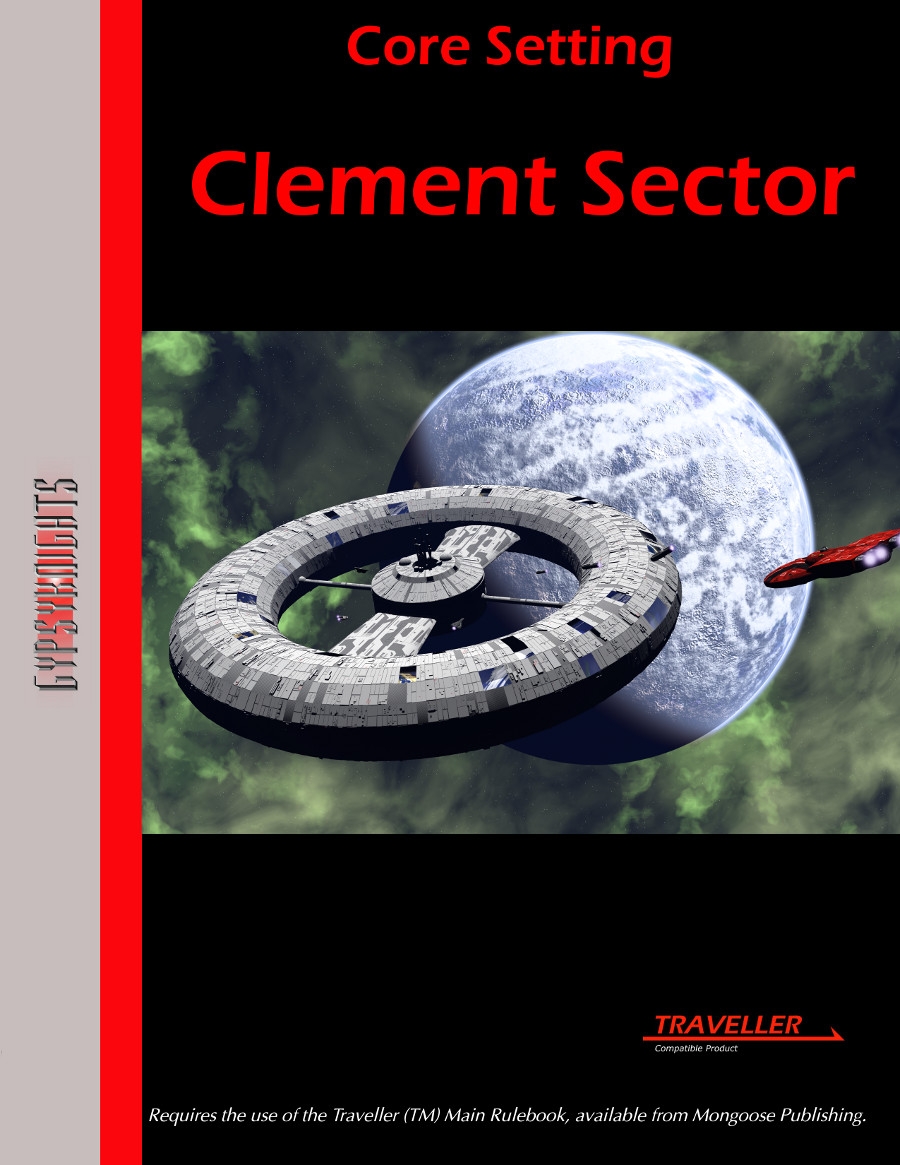Clement Sector
This review originally appeared on http://rpg-resource.org.uk in November 2014 and is reprinted here and in the July 2015 issue with permission
 Clement
Sector. John Watts.
Clement
Sector. John Watts.
Gypsy Knights Games http://www.gypsyknightsgames.com
140pp. hardbound, softcover or PDF
US$29.99(H)24.99(S+P)15.99(P)/UKú19.28(H)16.06(S+P)10.28(P)
This book presents an ‘alternate’ Traveller Universe setting, in which Gypsy Knights Games’s material is set. It’s an area of space on the far side of the galaxy from Earth, initially reached via a worm hole. The year is 2342, which makes the setting somewhat closer to 2300AD than most conventional Traveller settings. One of the chief differences is that the people you encounter still often feel connections and trace their roots back to a particular part of Earth.
There’s a lot to take in, beginning with the history of the Sector starting with the middle of the 21st century and explaining how the peoples of Earth explored first their own solar system and then went further afield, spurred on by the development of the Zimm Drive, which is based on quantum entanglement. In a way this is a primitive ‘Jump Drive’, taking ships out of normal space for a period of time and reinserting them a considerable distance away, some 2 parsecs, and leading to the colonisation of several relatively local star systems… and eventually to the discovery of the worm hole that led to the worlds of the Clement Sector. Over the next couple of centuries the area began to be explored and colonies established on suitable planets… and then one day the worm hole collapsed. The people in Clement Sector were now on their own.
This then leads into a detailed gazetteer of the entire sector, with charts and descriptions of every system, colonised or not. There's a lot of relatively unexplored real estate out there if exploration and colonisation interests you. For those areas which have been colonised, more copious details are found in the relevant sourcebook in this series, although there are brief notes here.
Next comes a section on character generation. One thing to note is that, apart from one called the Hub Federation, there are no interstellar governments—so anyone wanting to have government employment (including military service) in their background needs to decide which government they worked for! Most of the regular Traveller careers are available in some form, however. It is useful to determine a homeworld, and there are tables to do this if you prefer it to be random rather than by choice. Earth is included, as the worm hole did not collapse that long ago! This leads in to the allocation of background skills, including a range of survival skills depending on the sort of world the character grew up on.
For those wishing to enter the service of the Hub Federation there are notes on careers in the Navy (more details of this and other Hub Federation-specific careers are in the relevant sourcebooks), and there is also the option of entering the Cascadia Colonisation Authority. Otherwise, you can use most anything in the main Traveller rulebook. Another option is the Colonist career. Background information is provided to set the scene for these new careers.
Next come sections on technology and equipment, which are naturally somewhat different from standard Traveller although there is plenty of overlap and scope for using regular items in your game. Tech levels are generally around 10-11 with a cap at 12. This leads into starship design along with several specimens you can use, complete with illustrations, game statistics and plans.
Once we have the ships, there follows a section on starship operation, looking at everything from making a landing planetside to travelling across the sector. The discussion is wide-ranging, dealing with matters such as time and currency on the worlds you might visit as well as the nuts and bolts of using the Zimm drive to get around. Refuelling and piracy are also covered.
The next section looks at some of the larger and more significant corporations that may be encountered, names in the news, employers, suppliers, whatever interaction becomes necessary. There are plenty of plot seeds if you read the notes on each one carefully! Several organisations are given similar treatment (including a helpful bunch called the Gypsy Knights with a strangely familiar logo!).
The book ends with discussions on politics, religion and aliens. The politics in particular is expanded upon in other sourcebooks but it is a useful overview, particularly for those of worlds other than the ones you come from or know well. Finally there are suggestions for the type(s) of campaign you may wish to run in the Clement Sector… there’s wide scope here for whatever you might have in mind.
This is a beautifully-constructed and fascinating corner of space which is well worth exploring!
 Freelance
Traveller
Freelance
Traveller